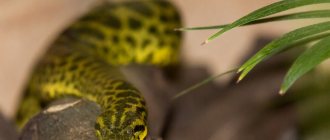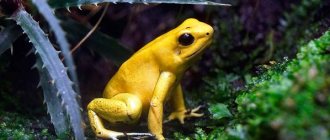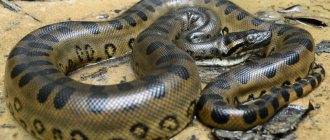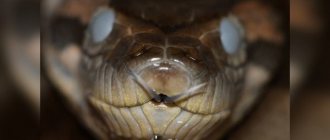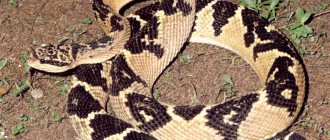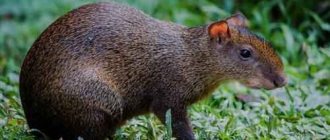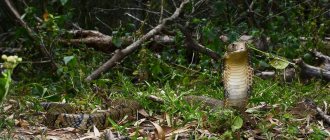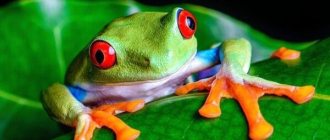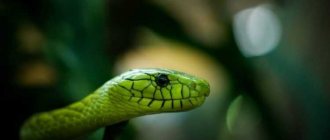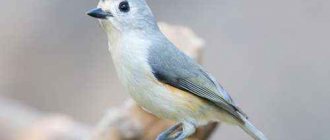Classification
- Kingdom: Animalia (animals)
- Phylum: Chordata
- Class: Reptilia (reptiles, reptiles)
- Order: Squamata (scaly)
- Suborder: Serpentes (snakes)
- Family: Boidae (pseudopods)
- Subfamily: Boinae (boa constrictors)
- Genus: Eunectes (anacondas)
As can be seen from the classification, the anaconda belongs to the boa constrictor family. Like pythons, they are classified as constrictor snakes, but the difference between these genera is significant - anacondas do not lay eggs, they are viviparous. Their closest relatives are common, tree and rainbow boas.
Varieties
Researchers identify four different species of anacondas, all of which are included in the taxonomic genus Eunectes. The term "Eunectes" is of Greek origin and means "good swimmer".
Each type differs from each other in unique features:
- Green anaconda (Eunectes murinus). This species is the most famous and largest of all anaconda species. The longest recorded specimen was 5.21 meters long and weighed 97.5 kg, but eyewitnesses have reported even larger specimens.
- Yellow anaconda (Eunectes notaeus). This species has a modest length of up to 3.6 meters. As the name suggests, the reptile's scales are yellow with dark brown markings.
Photo: Hugo Hulsberg
- Dark spotted anaconda (Eunectes deschanauensel). Researchers aren't even sure how many animals remain in this snake population. These reptiles are quite rare and elusive. Habitat destruction is threatening dark-spotted anacondas, but scientists aren't entirely sure how severe their decline is.
- Bolivian anaconda (Eunectes beniensis) . It was initially mistaken for a hybrid of the green and yellow species. More recently, based on genetic research, taxonomists created a separate clutch for this snake.
Scientific name of the species
In Latin, the genus of Anacondas is called Eunectes (this is if you ever need to show off your intellect powerfully), which translated means “good swimmer.” Water is truly their element. On land they are only silent, but in the water they are still swift and graceful. Gravity, what! The speed of a swimming anaconda is about 30 km/h, which is three times the maximum swimming speed available to a person.
For the name of the species - murinus - the anacondas clearly paid a bribe to some scientist, since it means “mouse eaters”. Well, technically, they can eat mice too, but they need a bunch of mice like a bag of seeds for a person.
We also recommend reading:
The largest dog breeds What is domestication in animal husbandry Why you should get a cat: reasons voiced by scientists Euthanasia of animals
Anaconda size
Most myths mention the enormous size of these snakes. However, since the 19th century, there has been a significant decline in anacondas. If at the beginning of the 20th century the statement that the anaconda is the largest snake in the world was true, then today the situation is different.
The events described in the stories and historical sources bear similarities to the adventures of Arthur Conan Doyle's characters in The Lost World (after all, both events take place in South America). These reports claim that there are snakes measuring 12, 19, 24 meters or even 35 meters! The problem with all these stories has always been the same - the absence of any evidence of the existence of such snakes.
Today we know that the longest wild anaconda whose length has been confirmed was... 521 cm. This is much less than Medusa, the longest reticulated python (767 cm).
Photo: xavierhc
The green anaconda, also known as the giant anaconda, is the largest species of its genus. This type of anaconda is especially popular among filmmakers, although other species are undoubtedly more beautiful. Dimensions of the giant anaconda:
- Body length: 4-4.5 meters (females), 2.5-3 m (males)
- Diameter: up to 30 cm (empty stomach), up to 1 m (at the widest section)
- Weight: 60-70 kg, rarely exceeds 100 kg
The longest green anaconda kept in captivity was 6.27 meters long at the time of its death (Pittsburgh Zoo). According to National Geographic, her weight was about 100 kg.
A characteristic feature of the anaconda, like birds of prey, is that its females are larger than males . Some sources claim that the maximum length of these snakes can exceed 9 meters and weight - 200 kg. The fact is that the reward of 50 thousand dollars for the discovery of an anaconda more than 9 meters long, funded by the Wildlife Conservation Society in the 1920s and still paid, has never been claimed... It is amazing that for almost a century not a single the man did not even qualify for the award.
Queen of Snakes: Interesting Facts
Anaconda is a snake that was considered little studied until the 20th century. Scientists, trying to find out some of the features of the reptile’s life and activity, moved for several years to live in places where it aggregated. Every new fact is news in the world of science.
Today the following is known about the anaconda:
- the female is larger and stronger than the male;
- scientific name – Eunectes;
- anaconda is the most “water-loving” snake;
- the snake strangles the victim until it feels the heartbeat;
- the teeth serve as a means of capturing the victim, the main power of the reptile is its muscles;
- females give birth to live fry, while other reptiles lay eggs;
- number of descendants – 25-30;
- from one brood, only 20-30% of individuals survive up to a year;
- at the beginning of the mating season, the female anaconda spreads a smell in the air that attracts the male;
- eyes and nostrils are located at the top of the head;
- growth does not stop throughout life;
- life expectancy in captivity is 5 years, in nature – 35-40;
- acids can dissolve even large bones;
- After a reptile defecates, it is impossible to tell which animal was eaten.
Anaconda
The largest anaconda in the world, which was caught and measured by a person, is not considered an indicator. After all, it is known that the length of a reptile in the wild can reach 15 meters or more. Facts known to scientists change the understanding of the real parameters of this giant every year. Perhaps in a few years a new record for the longest snake in the world will be set. After all, climate changes on the planet and a decrease in the number of reservoirs only contribute to the growth of this population. Every year the length of the anaconda increases.
Geographical distribution
Photo: Matthieu Berroneau
Anacondas live exclusively on the South American continent. Each species has its own unique range, but researchers aren't entirely sure of the exact range of some of the more hidden species. In general, these snakes can be found throughout the Amazon River basin and surrounding areas.
- Bolivian anaconda: Bolivia
- Dark spotted anaconda: French Guiana and northern Brazil
- Green anaconda (of the four species it has the widest habitat): Amazon and Orinoco river basins, Colombia, Venezuela, French Guiana, Ecuador, Peru, Bolivia, Trinidad and Tobago, Paraguay
- Yellow anaconda: parts of Brazil, Bolivia, Argentina and Paraguay.
Amethyst Python
It is a non-venomous snake from the Pythonidae family. Found in Indonesia, Guinea and Australia. According to unverified reports, it reaches a size of 8 m. However, herpetologists have not been able to find a single amethyst python longer than 6 m.
View this post on Instagram
A post shared by Victor Ray (@v1cr4v)
Only in 1990, scientists conducted a study of snakes on the island of Biak in Indonesia, where they caught a female 7.2 m long, which is considered the official record for these reptiles.
Habitat
Anacondas lead an amphibious lifestyle (they rarely climb trees due to their enormous body mass). All four species occupy similar habitats. Their favorite ecosystems are rivers, streams, lakes, swamps and flooded regions. Their dull-colored scales provide them with ideal camouflage in turbid waters rich in aquatic vegetation.
Anacondas can swim at a speed of 20 km/h and can stay underwater for up to 20 minutes. They sometimes crawl out of the water to hunt or sunbathe in tropical forests, savannas and grasslands.
Reproduction and development
During the dry season, male anacondas begin to look for females to breed. In search of a life partner, they travel vast distances. Anacondas mate and give birth either on land or in water.
After mating, anacondas carry their young for about 6-7 months. All species are ovoviviparous. The female gives birth to live offspring, usually 10 to 50 young (the largest recorded litter contained 100 snakes). Baby anacondas have a body length of about 75 cm and weigh up to 250 grams.
The young are already independent at birth (convenient, isn't it?) and leave their mother just a few hours after birth. Since the young are defenseless, they become easy prey for numerous predators. Only a few percent survive to adolescence - hence the huge number of offspring in one litter.
- Age of sexual or reproductive maturity: 3 to 4 years
- Mating system: polygamy (successive mating with multiple partners)
- Method of reproduction: ovoviviparous
- Gestation period: six months
- Number of cubs: several dozen
Cuban boa constrictor
This is the largest snake living in Cuba and the islands closest to it. The length of the boa constrictor is 4.8 m. Recently, the reptile is rare due to the fact that Cuban farmers exterminate the boa constrictor for meat and fat, which is also used for food. Boas are also caught for sale as pets to lovers of large reptiles.
View this post on Instagram
A post shared by Victor Ray (@v1cr4v)
The Cuban boa constrictor's calm attitude towards people makes it easy to study. In May 2022, the University of Tennessee published a study on the characteristics of boa hunting.
If you remember the boa constrictor Kaa from the famous cartoon, he hunted in splendid isolation. But scientists from the United States were able to document the coordinated hunting of bats by Cuban boa constrictors. The snakes created a living fence of several reptiles across the flight path of the prey. The opening was not counted (yet). Opponents point out that hunting 9 boa constrictors in one place does not mean joint hunting.
Diet
These reptiles are most active during sunrise and sunset, making them crepuscular animals. Anacondas are carnivores, which means that they eat other animals that they manage to catch and swallow. These are loners, spending most of their time in or near water, quietly waiting for prey in ambush.
Photo: Brad Moon
Smaller individuals eat:
- birds;
- fish;
- young caimans (crocodiles);
- frogs;
- small mammals;
- other snakes.
Adult anacondas feed on caimans, tapirs, turtles, capybaras, jacan birds, pudú (a type of deer), agouti (rodent) and many other vertebrates. There is also information about cannibalism among these snakes. Usually, the larger female eats the smaller male... as a snack after a lovey-dovey one-on-one conversation.
Photo: Brad Walker
The anaconda, like any other snake, strangles its victim, wrapping it in the coils of its body. The prey is swallowed whole and digested over several weeks. After a large meal, the anaconda usually fasts for a long period of time - even several months. In captivity, a record time of hunger strike was recorded - 2 years!
Attacks on people
An anaconda is big enough to swallow a human child. Unfortunately, some cases of human encounters with an anaconda have been fatal... As we know, this snake is capable of swallowing a victim up to ¼ of its body length and comparable weight.
However, anacondas live in relatively remote regions, so attacks on humans are not common. But even when meeting a person, anacondas in most cases crawl away, and only if they try to capture them will they try to bite. Considering that the anaconda's teeth are quite short, the marks from its bites heal quickly and without significant consequences.
Diamondback rattlesnake
This is a large and thick reptile that is considered the heavyweight champion among venomous snakes. The body size of record-breaking rattlers ranges from 1.8 to 2.4 m. Weight reaches 15 kg. But the majority are diamondback rattlers, 1.5–1.8 m long and weighing 56.5–56.8 kg.
View this post on Instagram
A post shared by Victor Ray (@v1cr4v)
Lives in the southeastern United States. Prefers coastal forests, places where shrubs accumulate, and damp areas of soil. Does not strive for frequent swimming, but overcomes rivers and small lakes.
Lifespan and conservation status
In their natural habitat, anacondas live up to 30 years, but in captivity they rarely live longer than 6 years. These reptiles sometimes become victims of pumas, jaguars, crocodiles, giant otters and other carnivores that can defeat an anaconda.
Habitat loss also poses a threat to snakes. Destruction of tropical forests for logging, agriculture, mining, and urbanization all reduce wildlife populations in anaconda habitats and therefore reduce their survival.
Unfortunately, people also kill anacondas for various parts of their bodies used in traditional medicine and religious rituals.
Burmese python
The large reptile with beautiful skin pattern and calm nature is known as the longest pet. Over 30% of “python lovers” purchase Burmese pythons. Unfortunately, people do not take good care of reptiles. When a pet grows up, it is often released into the “wild” urban environment.
Burmese pythons have spread throughout the jungles of Southeast Asia. Young reptiles spend most of their time in trees to escape predators. With age, body weight forces the python to switch to terrestrial living.
View this post on Instagram
A post shared by Victor Ray (@v1cr4v)
The record for the length of a Burmese python was set by a female from the Snake Safari Zoo, located in the suburbs of Chicago. The python has grown to 5.74 m. Some reports mention longer reptiles, but this is unconfirmed information. Scientists measured the "Burmese" to be only 4.5–5 m long.
